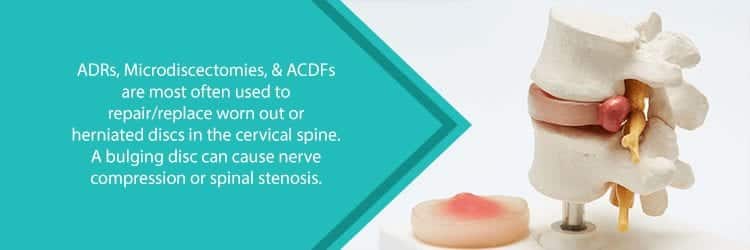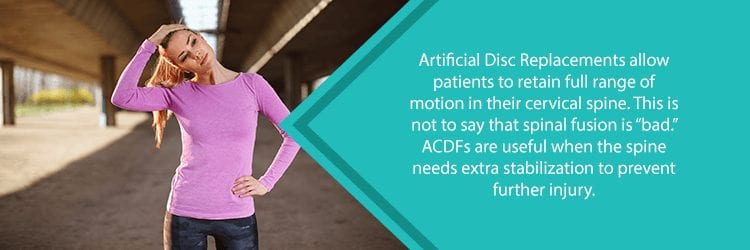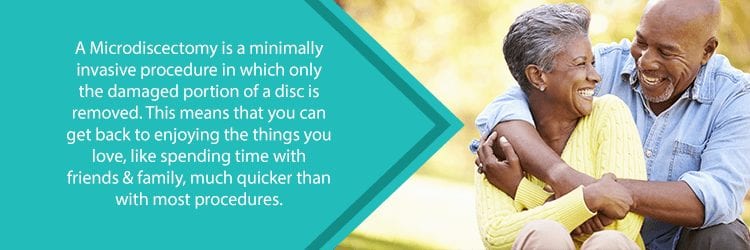If your neck pain is the result of a herniated disc or degenerative disc disease, then conservative treatments may provide only temporary relief. Consulting with an orthopedic doctor can provide minimally invasive options, such as microdiscectomy, that boast successful results.
You know you want the best treatment, but all the complex medical jargon can be overwhelming. Understanding the common procedures for neck pain is crucial to making an informed decision about your treatment.
Although cervical spine surgery can be scary, know that advances in medical technology have made these procedures safer and more effective than ever.
When Do I Need These Procedures?
In between each bone of the spine lies a protective cushion called a disc. These discs help our bodies absorb the shock from everyday movements like running, walking, and jumping. In addition, discs protect the spinal column during falls and other traumas. Each disc has a tough, fibrous membrane that encloses an elastic core.
A damaged disc usually occurs due to age, disease, or injury. In many cases, the elastic core breaks through the outer membrane, affecting the surrounding nerves. If the inner core causes the outer membrane to tear or rupture, it can put pressure on the spinal cord. This results in pain, weakness, and numbness in the neck that could extend to other parts of the body.
When a disc is damaged, surgical treatments are available to resolve the problem.
Understanding the Procedures
Listed below are the three common procedures that are available for treating neck pain. We’ve included the pros and cons of each procedure to help you make your most informed decision.
Anterior Cervical Discectomy & Fusion Surgery (ACDF)
For this procedure, the orthopedic surgeon makes a small cut in the front of the neck to remove the damaged disc. Then a bone graft is placed where the disc was removed to stabilize the area and help the vertebrae to fuse together.
In time, the two vertebrae fuse into one continuous strip in the area where the disc was removed. ACDF is the most common method for treating issues related to degenerative or herniated discs.
Pros:
- ACDF has proven success rates at around 90% for relieving neck pain and other symptoms.
- By performing spine surgery through the front of the neck, surgeons have easier access to the spinal column. This makes the surgery minimally invasive and results in a shorter hospital stay and quicker recovery times.
Cons:
- ACDF can cause Adjacent Segment Disease—an overloading of the spine near the site of the fusion. This can lead to bone spurs, spinal stenosis, or other issues. Studies suggest that this can occur in up to 25% of patients who receive fusion surgery.
- Fusion surgery is irreversible. You can’t choose to get another procedure, such as artificial disc replacement, after the bone grafts are set.

Artificial Disc Replacement (ADR)
A more recent trend for treating neck pain involves replacing the damaged disc with an artificial alternative. Like ACFD, the surgeon uses an incision at the front of the neck. Depending on your condition, the surgery involves total disc replacement or replacing the inner core of the disc. Artificial discs have various designs and can be made with metal or plastic-like materials.
Pros:
- Since this procedure doesn’t require a fusion of the vertebrae, you could expect to experience greater range of motion in your neck.
- It takes the body longer to fuse the bones together. Since ADR leaves the vertebrae intact, you can regain normal neck movements even quicker.
- This procedure carries less risk for Adjacent Segment Disease as well as complications from a bone graft not fusing properly.
Cons:
- Since this is a relatively new procedure, the long-term effects of ADR are not known. This includes how long these artificial discs will last.
- May not be appropriate for all spinal conditions.

Cervical Microdiscectomy
Unlike the other procedures, an orthopedic surgeon makes a small cut on the back of your neck. Once the surgeon gains access to the disc, he or she will remove the parts of it that cause irritation or compression of the spinal cord. Since, in many cases, the entire disc isn’t removed, spinal fusion is not necessary.
Pros:
- Scarring from the procedure is less visible since the incision is in the back of the neck.
- Can be a good option for those who want an alternative to fusion surgery.
- Quicker recovery time compared to removing the disc completely and fusing the vertebrae.
Cons:
- Since the disc isn’t completely removed, it has a small chance of becoming herniated again.
- Unlike ACDF or ADR, disc space cannot be increased to give the nerve root more space and prevent additional compression.
- Many surgeons prefer working on the discs from the front of the neck for ease of access.

The Bottom Line:
Each procedure has key risks and rewards. As with any surgical procedure, a chance of complications and infections isn’t out of the question. While all three of these procedures boast a relatively high success rate, the specific conditions that cause your neck pain need to be evaluated.
Discussing your diagnosis and treatment options with a qualified orthopedic surgeon will help you make a more informed decision about which procedure is right for you.
Getting the Help You Need
When your neck pain requires minimally invasive treatments, consulting with our spine experts at NJ Spine & Orthopedic can change your life. If you need an accurate diagnosis or second opinion, our board-certified surgeons will review your MRIs and suggest the most appropriate treatments for lasting results.
Don’t waste another day wondering how you will achieve relief from your neck pain. Scheduling an appointment at NJ Spine & Orthopedic can provide the best solution for returning to a pain-free life.

